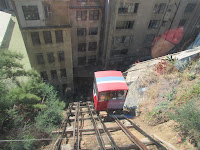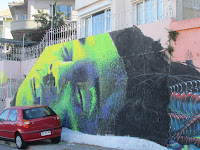Clarification: our trip is indeed over and we are back in Montreal. This post was written by David during the trip, but we didn't get the chance to post it, so here it is. There may be more to come.
 |
| View of Puerto Piramides. Note the road coming down to town on the left |
This is a remarkable story, in a remarkable place of
remarkable geography. Puerto Piramides, a very small village of a few hundred
people, is the only town on Argentina`s Valdes Peninsula, a vast barren
landscape of almost a million acres. Recently named a UNESCO World Heritage
site, the peninsula is Argentina`s answer to Chile`s Galapagos Islands. Despite
its desolate desert terrain, its shores swell with colonies of sea lions,
elephant seals, penguins and innumerable species of birds.
Every December, Piramides` beaches attract thousands of
visitors to witness one of nature`s more bizarre life-and-death spectacles. As
sea lion pups are just learning to swim, migrating Orca whales arrive offshore
anxious to feast on this vulnerable prey. Using their massive tails, Orcas stun
swimming pups, tossing them like rag dolls high into the air. Unfortunately for
these pups, Orcas do not restrict their hunting to the water. In their feeding frenzy,
Orcas use surging waves and tides to charge onto the beaches, swallowing
surprised pups as they awkwardly attempt to waddle away. On this video a colony of sea lions enjoys its daily life - orcas have already left.
By late January, when we arrived, the peninsula was once
more quiet and pastoral. We learnt that tens of millions of years ago the land
was actually an underwater seabed, composed of accumulated crustacean shells, hundreds
of meters thick. This ancient seabed now seats as a high plateau above the
surrounding sea. Piramides, like all the peninsula`s beaches, lies at the
bottom of a very long, steep road that winds its way down from the high
plateaus to the ocean.
 |
| The main (and only) street |
We spent a wonderful week exploring the exotic fauna and
landscapes by car, bike, and foot. It was now Sunday evening, our last night on
the peninsula. We grabbed a pizza and went to watch the dazzling sunset over
the beach. As the evening skies glowed from the southern horizon, we walked
back to the town`s main and only street. This being Sunday, and the last day of
holidays for many, the street overflowed with vacationers enjoying a last casual
stroll, campers snatching a hurried
supper, and children playing everywhere.
.jpg) |
| View from the road down |
We were enjoying our ice creams at a roadside table, when
we heard and then felt the hot draft of a truck racing by. We instinctively
turned to the street and caught a glimpse of an old truck charging madly through
town. It pulled a long trailer heavily loaded with massive telephone poles. The
stench of burning brakes filled the air. The truck had obviously come speeding down
the steep road, unable to slow down. There was stunned silence. We ran towards
the street, bracing ourselves for the carnage that was surely being wrecked
down the street.
But, on reaching the street, we saw that the truck had already
passed through, stopping on the rise at the far side of the town. The street
was once again congested with people, cars and bicycles. The holiday buzz and
traffic resumed. Somehow, this deadly truck had found its way through the
clogged streets without hitting a thing. Had we just passed through the
Twilight Zone? It was simply a miracle that still haunts us.





































